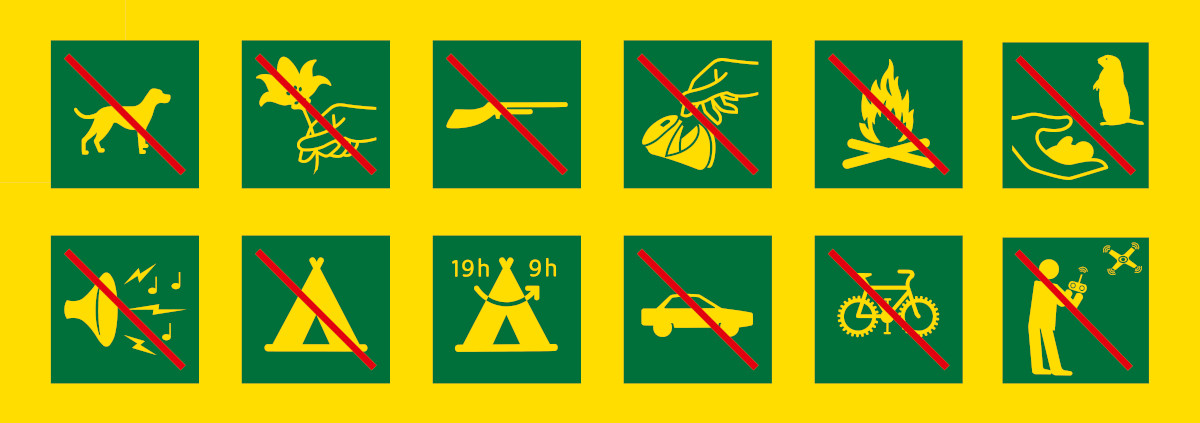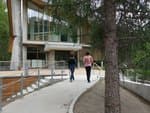La Bosse de Clapouse
"In the enchanting light of the larch undergrowth, mesmerised by the playful tree keepers that searched the tree trunks at breath taking speed looking for the odd insect that might be hidden in a crack of the bark, I had not even noticed the female grouse that was resting on a low branch. We spotted each other with mutual surprise. The magic led to the noisy departure of the bird. I was the trespasser"
Christophe Albert, warden in the Vallouise area
16 points of interest
 Fauna
FaunaRoe Deer
Hidden in the larch forest, the Roe Deer sometimes shows its fine head at dawn or at dusk. Not always easy to see this discreet animal but a few tracks or droppings can give its presence away.: the heart shaped print of its delicate hooves, the trunks of shrubs nicked by young fallow deer rubbing new antlers there to remove the last shreds of velvet, Sometimes it is a deep sonorous and guttural bark that resonates in the woods.
 Fauna
FaunaEurasian Tree Creeper
The Eurasian Tree Creeper is a small, compact and agile bird. Its beak is long and curved and its tail is composed of stiff feathers. Its long claws have sharp nails. So many adaptations enabling it to explore the bark of the larch trees where it hunts for insects and other spiders which make up its diet all through the year.
 Fauna
FaunaWestern Bonelli’s Warbler
This common little sparrow is rarely seen but often heard. It interprets a brief song lasting just a few seconds, with around ten repetitive notes, which quickly become identifiable, rather haunting. The male sings almost throughout the year, from April to July, then only in the morning in July. After the storm when the trees are still dripping with rain, he starts singing immediately. At the end of August males et females leave for the African savannah forest regions, followed by that years young.
 Fauna
FaunaWhite Throated Dipper
Stocky, short tail, tapered beak, the White Throated Dipper is often perched in the middle of a torrent, on a boulder at water level. Recognizable by the white mark on its chin and chest and the rest of its red and slate grey plumage, this bird dives in the icy water looking for aquatic larvae which are the essential ingredient of its menu.
 Fauna
Fauna Flora
Flora Fauna
Fauna Fauna
FaunaWallcreeper
The wallcreeper inspects the rock face by latching on to it with long efficient claws. Its long thin beak enables it to capture the best-hidden insects in the tiniest of cracks in the rock. This capacity is only equalled by its deep red feathers that make it seem like a butterfly, as it performs its airborne acrobatics. Flora
Flora Fauna
Fauna Fauna
Fauna Flora
Flora Flora
Flora Fauna
Fauna Flora
Flora Flora
Flora
Description
From the car park, walk up the Sélé valley by the footpath that follows the left bank of the Celse Nière stream.
- At the post, 1572 m, cross the footbridge over the stream to the left. (It is taken down from November to June) Go up the right bank of the stream by the Clapouse footpath, then head diagonally to the left to meander up the slopes alternating through larch and green alder. The route then ingeniously leads to the ledges and crosses ravines before coming to the Clapouse valley. La Bosse (the bump) is the small summit that is reached by following a footpath.
- The return trip is made by the same itinerary in the opposite direction.
- Departure : Ailefroide
- Towns crossed : Vallouise-Pelvoux
Forecast
Altimetric profile
Sensitive areas
Golden eagle
- Impacted practices:
- Aerial, , Vertical
- Sensitivity periods:
- JanFebMarAprMayJunJulAug
- Contact:
- Parc National des Écrins
Julien Charron
julien.charron@ecrins-parcnational.fr
Recommandations
On this sometimes-steep footpath, the footbridge across the Celse Nière stream is dismantled from November to June. No camping after Ailefroide, bivouac permitted at least an hour's walk away from the park boundaries. No fires.
Information desks
Vallouise Park house
, 05290 Vallouise
Information, documentation, models, exhibitions, screenings, product sales and works of the Park. Guided tours for school, reservation required. The new Park House opened in Vallouise since June 1, and offers visitors an interactive permanent exhibition inviting to explore the area and its heritage. A temporary exhibition space will allow a renewed offer. Finally, the device is completed by an audiovisual room to organize screenings and conferences Free admission. All animations of the Park are free unless otherwise stated.
Transport
SNCF railway station in l'Argentière-la-Bessée then shuttle to Ailefroide during the summer season (reserve 36 hours in advance at 05voyageurs or call 04 92 502 505.
Access and parking
From the N94 in L'Argentière, head towards Vallouise, then Pelvoux. You will then reach the hamlet of Ailefroide by the D994F
Parking :
Source

Report a problem or an error
If you have found an error on this page or if you have noticed any problems during your hike, please report them to us here:


